Video by via Dailymotion Source O presidente francês iniciou, esta terça-feira, uma visita de dois dias aos Países Baixos, na qual se espera que esclareça as declarações polémicas efetuadas na viagem à China, defendendo a “autonomia estratégica” da União Europeia em relação aos Estados Unidos. Go to Source
Nirmala Sitharaman’s Reply To Query On ‘Violence Against Muslims’ In India
Argus News is Odisha’s fastest-growing news channel having its presence on satellite TV and various web platforms. Watch the latest news updates LIVE on matters related to politics, sports, gadgets, business, entertainment, and more. Argus News is setting new standards for journalism through its differentiated programming, philosophy, and tagline ‘Satyara Sandhana’.
To stay updated on-the-go,
Visit Our Official Website: www.argusnews.in
iOS App: http://bit.ly/ArgusNewsiOSApp
Android App: http://bit.ly/ArgusNewsAndroidApp
Live TV: https://argusnews.in/live-tv/
Facebook: https://www.facebook.com/argusnews.in
YouTube:
/ theargusnewsodia
Twitter: https://twitter.com/ArgusNews_in
Instagram: https://www.instagram.com/argusnewsin
Argus News Is Available on:
TataPlay channel No – 1780
Airtel TV channel No – 609
Dish TV channel No – 1369
d2h channel No – 1757
SITI Networks – 18
Hathway – 732
GTPL KCBPL – 713
& other Leading Cable Networks please visit https://argusnews.in/channel_number for channel number list
You Can WhatsApp Us Your News On- 8480612900
#ArgusNews #ArgusEnglish #nirmalasitharaman #financeminister #violenceagainstmuslim #India
Quem os preparativos para o casamento atrapalharam? | Mil e Uma Noites – Episódio 27
Siga o canal
#MileUmaNoites #série turca #dublada em português
Specbee: Revitalize Your Forms: Enhancing User Experience with Drupal’s Form API
Nitin Lama
11 Apr, 2023
Did you know “form fatigue” is a thing?! It’s a feeling of exhaustion when you have to fill out too many forms. But forms are an integral part of a website and no site owner can (or should) do without them. So how can you make sure your website helps reduce form fatigue? Easy! Keep it simple and short, offer clear and concise instructions, break up long forms, and use autofill. Most important of all, make sure you’re offering a breezy user experience to fill them out.
Drupal’s Form API offers a way to create easily customizable and themeable forms to blend well with any website. It provides developers with a set of functions and APIs to create, validate and process forms in Drupal. Take a deeper dive into the amazing Drupal Form API and find out how you can implement it in your next project.
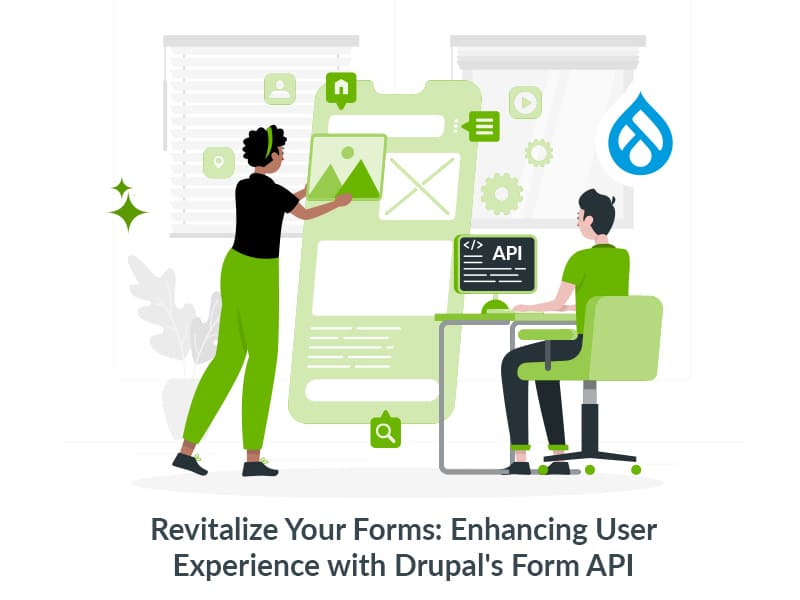
Why Form API
As you know, forms are a crucial part of every website because they allow users to interact with them by submitting data. Using Drupal’s Form API, developers can create unique forms for various purposes, including contact, login, and registration. A few reasons why you should consider Form API:
- It is easy to use and does not require much coding experience. You can create forms using a set of simple and intuitive functions.
- It provides built-in validation functions that allow you to validate form data easily.
- Comes with built-in security features that help prevent attacks like cross-site scripting (XSS) and cross-site request forgery (CSRF).
- It is highly customizable and can be used to create complex forms with multiple fields, buttons, and actions.
- Form APIs are themeable, so developers can change CSS and HTML to make their forms look however they want.
- It can be easily integrated with other Drupal APIs.
Things you need to know before building forms
There are various kinds of forms that are often used in Drupal. Each contains a base class that you can extend in a unique module of your own design.
First, identify the type of form you need to build:
- A generic form. Extend FormBase.
- A configuration form that enables administrators to update a module’s settings. Extend ConfigFormBase.
Any form that has FormBase in its hierarchy must implement the following methods since FormBase implements FormInterface.
To create a generic custom form with the Form API, you’ll need to define a function that returns an array of form elements inside buildForm(). The key of each element is the name of the form element, and the value is an array of properties that define the element. For example, to create a text field, you would define an element like this:
$form['emp_name'] = [
'#type' => 'textfield',
'#title' => $this->t('Enter Name'),
'#required' => TRUE,
];
Adding validation
Form API also provides a way to validate user input. You can add validation functions to your form definition that will be called when the form is submitted. If a validation function returns an error message, the form submission will be prevented and the error message will be displayed to the user.
To add a validation function, you will need to implement a validateForm().
Processing form submissions
When a form is submitted, Drupal calls a submission function that you define. The submission function can perform any necessary processing of the form data, such as saving it to the database
To define a submission function, you will need to implement a submitForm()
Integrate the form in a request
To integrate this form into a Drupal site’s URI structure, use a route like the following:
example.form:
path: '/example-form'
defaults:
_title: 'Example form'
_form: 'DrupalexampleFormExampleForm'
requirements:
_permission: 'access content'
The _form key tells the routing system that the provided class name is a form class to be instantiated and handled as a form.
Creating a custom form with Drupal Form API
Follow these easy step to begin the process of creating a custom form with Drupal’s Form API:
- Create a .info.yml inside a custom module. (As we are creating a separate module for custom forms, this step is not required for adding forms in an existing module).
- Create a form class for returning the form array. (custom_module/src/Form/Registration.php)
- Create a .routing.yml file
- Create a .module and hook_form_alter() and/or hook_form_FORM_ID_alter() to alter the form (If needed).
Here is a complete example of an employee registration form:
Folder structure:
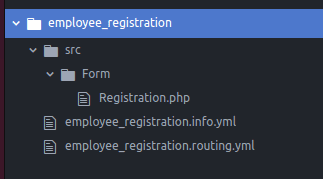
1. employee_registration.info.yml
name: Employee Registration Form
type: module
description: Custom module for implementing custom employee registration form.
core_version_requirement: ^9 || ^10
package: Custom
2. src/Form/Registration.php
'textfield',
'#title' => $this->t('Enter Name'),
'#required' => TRUE,
];
$form['emp_no'] = [
'#type' => 'textfield',
'#title' => $this->t('Enter Employee Number'),
'#required' => TRUE,
];
$form['emp_mail'] = [
'#type' => 'email',
'#title' => $this->t('Enter Email ID'),
'#required' => TRUE,
];
$form['emp_phone'] = [
'#type' => 'tel',
'#title' => $this->t('Enter Contact Number'),
];
$form['emp_dob'] = [
'#type' => 'date',
'#title' => $this->t('Enter DOB'),
'#required' => TRUE,
];
$form['emp_gender'] = [
'#type' => 'select',
'#title' => $this->t('Select Gender'),
'#options' => [
'Male' => $this->t('Male'),
'Female' => $this->t('Female'),
'Other' => $this->t('Other'),
],
];
$form['submit'] = [
'#type' => 'submit',
'#value' => $this->t('Save'),
'#button_type' => 'primary',
];
return $form;
}
/**
* {@inheritdoc}
*/
public function validateForm(array &$form, FormStateInterface $form_state) {
if (strlen($form_state->getValue('emp_phone')) setErrorByName('emp_phone', $this->t('The phone number is too short. Please enter a full phone number.'));
}
}
/**
* {@inheritdoc}
*/
public function submitForm(array &$form, FormStateInterface $form_state) {
// Processing form data.
$this->messenger()->addMessage($this->t("Employee Registration Done!!"));
foreach ($form_state->getValues() as $key => $value) {
$this->messenger()->addMessage($key . ': ' . $value);
}
}
}
3. employee_registration.routing.yml
employee_registration.form:
path: '/registration-form'
defaults:
_title: 'Employee Registration'
_form: 'Drupalemployee_registrationFormRegistration'
requirements:
_permission: 'access content'
Result:
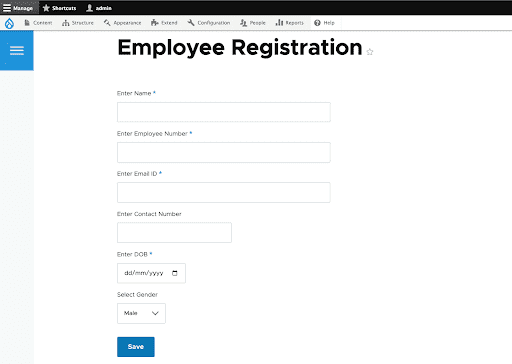
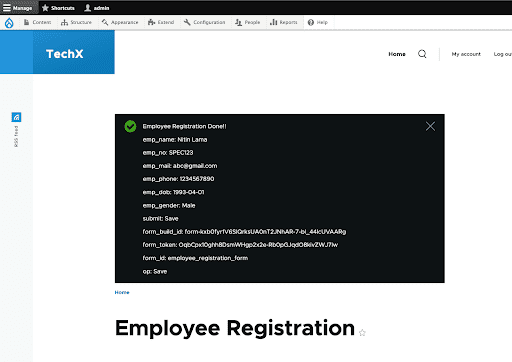
Final Thoughts
Form API lets you create complex and customized forms with validation and processing functions in Drupal. When you use Form API, you can be sure that your forms are consistent and easy to use for your users. Looking for a Drupal agency to help you build a user-friendly experience for your audience? Talk to our Drupal experts today!
OpenBSD 7.3 released
Calgary and elsewhere, 2023-04-10:
The OpenBSD project today announced the release and general availability of its latest stable version, OpenBSD 7.3.
Eagerly anticipated by users, engineers, enthusiasts and industry pundits all over the world, this release contains a number of improvements over earlier versions, including but not limited to
- Improved hardware support, including new arm64 variants and numerous network and graphics driver updates
- Improved general and network performance due to steadily improving multi-core support
- More flexible network configuration,
now supporting lladdr-based config
[See earlier report.] - retguard for amd64 system calls
[See earlier report.] - Enhanced memory and process security [See earlier report]
- Relinking of network exposed daemons at boot time
[See earlier report.] - execute-only (xonly)
[See earlier report.] pinsyscall(2)
[See earlier report.]- Improved versions of OpenSSH (9.3), LibreSSL (3.7.2), OpenBGPD (7.9) …
- Support for disk encryption in the installer
[See earlier report.] - X11 Mesa shader cache enabled.
- More aggressive randomisation of the stack location for all 64-bit architectures except alpha
[See earlier report.]
You may notice that the list of OpenBSD Innovations has grown a bit too, while the detailed changelog offers more detail.
All reasonably modern architectures had install sets and complete binary packages available on the mirrors at the time of the announcements.
Some slower (historic or just weird) architectures are still building but OpenBSD still supports 14 architectures.
While you are waiting for your downloads, installs or upgrades to complete (or even before starting either), please remember to visit the donations page and/or buy OpenBSD swag to support the project financially.
And finally, this release is the first since OpenBSD 7.0 to feature a release song. The Wizard and the Fish is the new obligatory addition to your hacking playlist.
How DARPA Leverages Open Source to Secure 5G
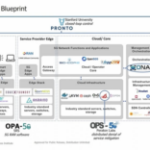 This post is based on a presentation by Tejas Patel, program manager in the information innovation office at DARPA, given during ONE Summit North America 2022.
This post is based on a presentation by Tejas Patel, program manager in the information innovation office at DARPA, given during ONE Summit North America 2022.
The post How DARPA Leverages Open Source to Secure 5G appeared first on Linux.com.








